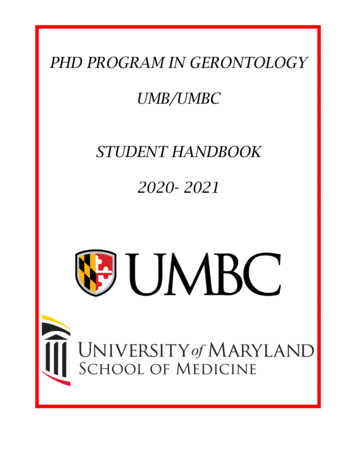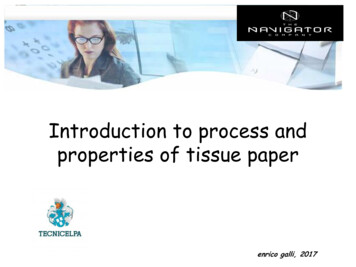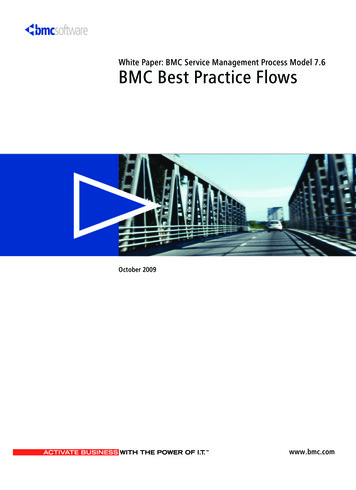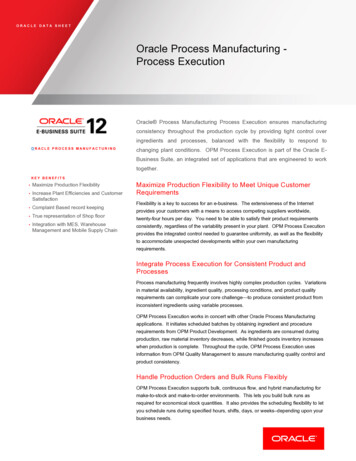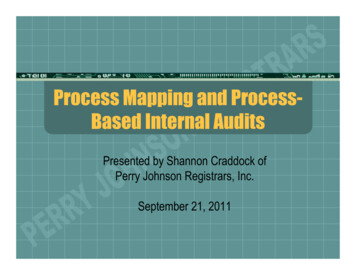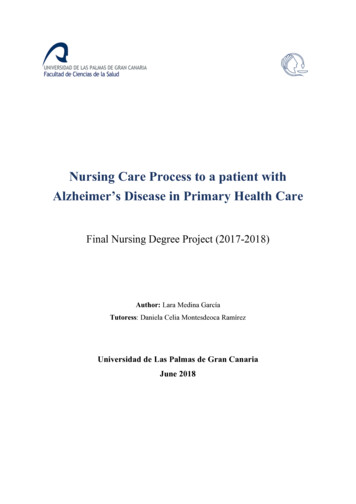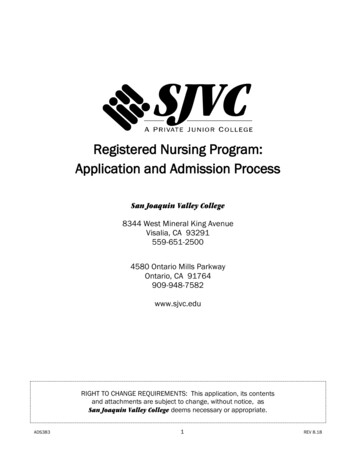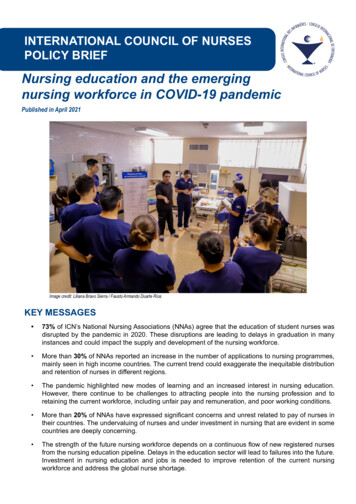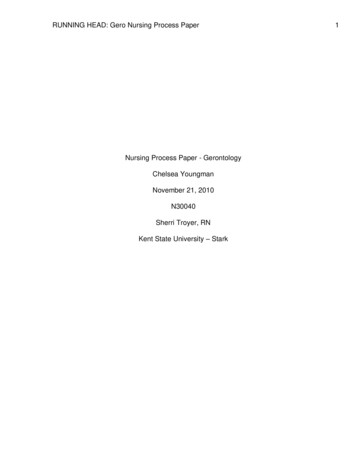
Transcription
RUNNING HEAD: Gero Nursing Process PaperNursing Process Paper - GerontologyChelsea YoungmanNovember 21, 2010N30040Sherri Troyer, RNKent State University – Stark1
Gero Nursing Process Paper2Client ProfileA 78 year old widow was admitted to a long-term care facility on 8/12/2010. Thepatient was admitted from an acute care facility for rehabilitation of a right femur fractureand atrial fibrillation. The patient has a history of type II diabetes, coronaryarthrosclerosis, and hypertension. The patient also had an ORIF (open reductioninternal fixation) surgery.Admission Medical Diagnosis and Chief ComplaintThe patient was admitted with a right femur fracture and atrial fibrillation.Primary Medical DiagnosisFx FemurAccording to Black and Hawk, a fracture is the disruption in the normal continuityof a bone. (pg 507) A fracture can result from more stress being put on the bone thanwhat the bone can hold. The severity of a fracture depends on what cause the fractureto happen. Depending on the type of accident, the bone can just crack to completelyshatter. When a bone is fractured, the muscles that attach to the end of the bone aredisrupted. Bleeding also occurs from the damaged ends of the bone and from the softtissue. (Black & Hawk, pg 508)The most common way to diagnose a bone fracture is by using x-ray. The x-raytechnologist must take the x-ray at the correct spot and the correct angle in order for a
Gero Nursing Process Paper3fracture to be properly diagnosed. The x-ray also needs to include the joints surroundingthe bone to identify any other complications that could occur. Some abnormal findingson the x-ray would include soft tissue edema or air displacement due to the shift of thebone. (Black & Hawk, pg 509)There are two types of classifications of fractures, closed and open fractures.Closed fractures has skin intact over the injury site. Open fractures do not have skinintact over the injury site. Open fractures are classified as grade I, grade II, or grade IIIdepending on their severity. Grade I open fractures are smaller than 1cm and have littleto no contamination. Grade II open fractures has a wound larger than 1cm and have amoderate amount of contamination. Grade III open fractures has a wound greater than6cm and there is extensive damage involved. (Black & Hawk, pg 510)Atrial FibrillationAtrial fibrillation (AFib) is when the heart's two upper chambers called the atria donot beat properly. The improper beating does not allow the blood to be pushedcompletely out of the atria so it can pool or clot. If a piece of the clot breaks off, it canfollow an artery to the brain and cause a stroke. (AHA, 2010)
Gero Nursing Process Paper4Symptoms of Afib include heart palpitations, decreased blood pressure,generalized weakness, lightheadedness, confusion, shortness of breath, and chestpain. There are two types of Afib, occasional and chronic. Occasional Afib, also calledparoxysmal atrial fibrillation, is when the symptoms come and go. They could last forminutes to several hours. Chronic Afib is when symptoms persist usually until treated.Many people do not even know they have Afib until they are diagnosed during aphysical examination. There are many different causes of atrial fibrillation that includehigh blood pressure, heart attacks, smoking, lung disease, and viral infections. Riskfactors for atrial fibrillation include smoking, drinking excessive amounts of alcohol, highblood pressure, and family history. (Mayo Clinic, 2010)Other Medical DiagnosesType II DiabetesType II diabetes is the most common form of diabetes. Millions of people havetype II diabetes, but some are more at risk to have it. Type II diabetes is more commonin African Americans, Latinos, Native Americans, and Asian Americans, NativeHawaiians and other Pacific Islanders, as well as the aged population. In Type IIdiabetes the body does not produce enough insulin or the cells ignore the insulin.Insulin is needed so the body can take the glucose into the cells and use it as energy.Some symptoms of Type II Diabetes are: frequent infections, blurred vision, cuts/bruisesthat are slow to heal, tingling/numbness in the hands/feet, recurring skin, gum, orbladder infections. Often people with type II diabetes have no symptoms. The best way
Gero Nursing Process Paper5to prevent diabetes is to live a healthy lifestyle. This includes maintaining a healthyweight, changing your diet, and increasing your physical activity level.Another way to prevent diabetes is to have your blood glucose checked yearly if you are45 and overweight and if under the age of 45, overweight, and have a family history ofdiabetes. (Diabetes, 2010)Coronary atherosclerosisCoronary atherosclerosis is a type of arteriosclerosis (meaning thickening orhardening of the arteries). Atherosclerosis is caused by the build up of plaque on thelining of an artery. Plaque is deposits of fatty substances, such as cholesterol, calcium,and fibrin. This causes the artery wall to thicken and loose its elasticity. Atherosclerosisis a disease of arteries only, it does not occur in veins. It usually starts late in childhoodand progressively gets worse as one ages. It is usually asymptomatic. It can becomesymptomatic if it interferes with blood to the brain. It can cause stroke, heart attacks,and heart failure. Symptoms of atherosclerosis include chest pain and abnormal heartrhythms. (Heart Disease, 2005)HypertensionHypertension is when your blood pressure stays in the high blood pressure range(usually 140/90). When your blood pressure is not under control it can cause damage toyour blood vessels, heart, and kidneys. It can cause stroke and/or MI. HTN doesn'tusually have signs or symptoms while it is doing the damage. There is no exact causeof HTN but being overweight, eating unhealthy, smoking, drinking, too much Na in your
Gero Nursing Process Paper6diet, family history of HTN are all risk factors. Very high blood pressure can causeheadaches, blurry vision, nausea, and vomiting. Most people are diagnosed with HTNwhen they go to the doctor for their routine visit. You must have a blood pressure of140/90 three consecutive times and usually it is 1 to 2 weeks apart (Mayo Clinic, 2010).Surgical HistoryORIFORIF (open reduction internal fixation) is the surgical repair of a fracture. As soonas you are medically stable, you will be prepared for surgery. First, you will be given ageneral anesthesia. The doctor will then make an incision at the hip area and realignyour bones. The bones are then held in place by surgical fixations. For a femur fracture,the doctor will use multiple screws to hold the bones in place for proper healing. Afterthe surgery, you will be taken to the post-op area for observation. Once you are stable,you will then be admitted to an orthopedic floor in the hospital. You will spend a fewdays in the hospital. You will be provide physical therapy and occupational therapy.Once the doctor sees that you are fit to be discharged, you will either be discharged tohome or to a rehabilitation facility depending on your needs. (dcorthodocs, 2010)
Gero Nursing Process Paper7Medication Prep Sheet*Medication information obtained from Davis’s Drug Guide for Nurses 11th editionMedication(Generic /orTrade)ClassificationWhy is your patienttaking this drug?Nursing ImplicationsSide EffectsHx of hypertensionMonitor BP and pulsefrequently during initialdose adjustment andperiodically throughouttherapy. Notify healthcare professional ofsignificant changes.Monitor frequency ofprescription refills todetermine adherence.Assess patient for signsof angioedema (dyspnea,facial swelling).Dx of femur fractureAssess for signs ofbleeding andhemorrhage. Notify healthcare professional if theseoccur. Assess patient forevidence of additional orincreased thrombosis.Symptoms will depend onarea involvement. Monitorpatient forhypersensitivity reactions.Observe pts withcathedars for neurologicaleffect SC: observeinjection sites forhematomas, ecchymosis,or inflammation.Hx of hypertensionMonitor vital signs andECG every 5-15 minutesduring and for severalhours after parenteraladministration. MonitorDizziness,drowsiness,fatigue, headache,insomnia, cough,vertigo, weakness,cough, dyspnea,hypotension, chestpain, edema,tachycardia,hyperuricemia,taste disturbances,abdominal pain,anorexia,constipation,diarrhea, nausea,vomiting, erectiledysfunction,proteinuria, renaldysfunction, nia, edema,constipation,nausea, reversibleincrease in liverenzymes, vomiting,urinary retention,ecchymoses,prutius, rash,urticaria, bleeding,anemia,thrombocytopenia,erythema atinjection site,hematoma,irritation, pain,feverFatigue,weakness, l40 mg Po qd8:00 : ACEinhibitorsLowering of bloodpressure inhypertensive patients.Lovenox30 mg SQ BID 8am & 8 ombotics.Prevention ofthrombus formation.Metoprolol25 mg PO BID 8antianginals,antihypertensives,beta blockers,Hypertension, anginapectoris, prevention of
Gero Nursing Process Paperam & 4 pmMI and decreasedmortality in patientswith recent MI.NorvascTherapeutic:antihypertensives8Hx of hypertension5 mg PO qd 8amPharmacologic:calcium channelblockersSystemic vasodilationresulting in decreasedblood pressure.Coronary vasodilationresulting in decreasedfrequency andseverity of anginaattacks.NovologSliding scaleTherapeutic:antidiabetics,hormonesSQ qid 6 am, 11am, 4 pm, 8 pmPharmacologic:pancreaticsHx of type 2diabetesControl ofhyperglycemia indiabetic patients.Tylenol650 mg PO PRNTherapeutic:Antipyretics,nonopioid analgesicsAnalgesiaAntipyresisPain r/t femur fxintake and output ratiosand daily weights. Assessroutinely for signs andsymptoms of CHF(dyspnea, rales/crackles,weight gain, peripheraledema, jugular venousdistention. Monitorfrequency of prescriptionrefills to determinecompliance.Monitor blood pressureand pulse before therapy,during dose adjustment,and periodically duringtherapy. Monitor ECGperiodically duringprolonged therapy.Monitor I&Os and dailyweight. Assess for signsof CHF (peripheraledema, rales/crackles,dyspnea, weight gain,and jugular veindistention). Assesslocation, duration,intensity, andprecipitating factors ofpt’s angina pain.Assess patientperiodically for symptomsof hypoglycemia andhyperglycemia duringtherapy. Monitor bodyweight periodically.Changes in weight maynecessitate changes ininsulin dose.insomina, memoryloss, mental statuschanges,nervousness,nightmares,blurred vision,stuffy nose,bradycardia,Pulmonary edema,hypotensionAssess overall healthstatus and alcohol usagebefore administeringacetaminophen. Patientswho are malnourished orchronically abuse alcoholare at higher risk ofdeveloping hepatotoxictywith chronic use of usualdoses of this drug.hepatic failure,hepatictoxicity(overdose), renalfailure (high doses/chronic use),neutropenia,pancytopenia,leucopenia, rash,urticariaPain: assess type,location, and intensityprior to and 30-60 minfollowing administration.Fever: assess fever; noteHeadache,dizziness, fatigue,peripheral gingivalhyperplasia,nausea, flushinghypoglycemia,lipodystrophy,pruritus, erythema,swelling, allergicreactions includinganaphylaxis
Gero Nursing Process PaperCoumadinAnticoagulants1 mg PO BID 8am & 4 pmCoumarins9Dx of femur fracturePrevention ofthromboembolicevents.Vicodin5-500 mg POPRNTherapeutic: allergy,cold, and coughremedies, opioidanalgesicsPharmacologic: opioidagonists/nonopioidanalgesicscombinationsPain r/t femurfracturepresence of associatedsigns (diaphoresis,tachycardia, and malaise)Assess patients for signsof bleeding andhemorrhage (bleedinggums, nosebleed,unusual bleeding, tarryblack stools, hematuria,fall in hematocrit/BP,guaiac positive stools,urine, or nastogastricaspirate. Assess patientfor evidence of additionalor increased thrombosis.Before administering,evaluate recent INR orPT results and havesecond nurseindependently checkorder and dosagecalculations. Carefullymonitor when new agentsare started or otheragents are discontinued.Administer medications atsame time each day.Medication requires 3 to 5days to reach effectivelevels, usually it is begunwhile patient is still onheparinAssess BP, pulse, andrespirations before andperiodically duringadministration. Ifrespirations are 10/min,assess level of sedation.Assess bowel functionroutinely. Assess type,location, and intensity topain prior to and 1 hourfollowing administration.Assess cough and lungsounds during antitussiveuse.Cramps, nausea,dermal necrosis,bleeding, feverConfusion,dizziness,sedation, euphoria,hallucinations,headache, unusualdreams, blurredvision, diplopia,misos, tipation,dyspepsia,nausea, vomiting,urinary retention,sweating, ce
Gero Nursing Process Paper10Laboratory AnalysisTest DateTestName9-16-2010 PT9-16-2010 .4 Interpretation of Abnormal Results For YourClientPt is taking coumadin/lovenox1.1 Pt is taking coumadin/lovenox* Normal range values and interpretation obtained from Nurse’s Manual of Laboratoryand Diagnostic Tests 4th
Gero Nursing Process Paper11Braden Risk Assessment Scale2 – VeryLimitedResponds onlyto painfulstimuli.Cannotcommunicatediscomfortexcept bymoaning orrestlessness.OR has asensoryimpairmentwhich limitsthe ability tofeel pain ordiscomfortover half ofbody.2 – Very Moist3 – SlightlyLimitedResponds toverbalcommands, butcannot alwayscommunicatediscomfort orneed to beturned OR hassome sensoryimpairmentwhich limitsability to feelpain ordiscomfort in 1or 2 extremities.4 – NoImpairmentResponds toverbalcommands. Hasno sensorydeficit whichwould limit abilityto feel or voicepain ordiscomfort.3–OccasionallyMoist4 – Rarely MoistSkin is keptmoist almostconstantly beperspiration,urine, etc.Dampne
Nursing Implications Side Effects Lisinopril 40 mg Po qd 8:00 am Therapeutic: antihypertensives Pharmacologic: ACE inhibitors Lowering of blood pressure in hypertensive patients. Hx of hypertension Monitor BP and pulse frequently during initial dose adjustment and periodically throughout therapy. Notify health care professional of significant changes. Monitor frequency of prescription refills .

